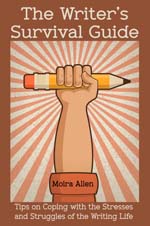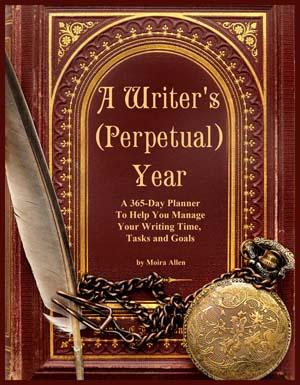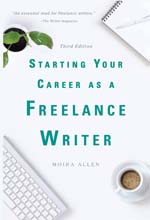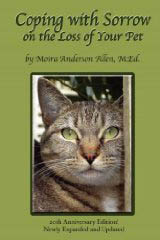 Your Guide to a Successful Writing Career
| |||
|
by Dawn Copeman
Press releases are one of the most effective means of advertising a business can use. Press releases are basically a one or two page announcement of a new product, new trend, new business premises, in fact anything that can in any way be described as newsworthy. Well-written press releases are loved by journalists as they provide them with much needed content, either as short news items or items that can be developed into longer articles. This is why press releases are so effective; they don't look like advertising but if done well they get lots of publicity for the client. Precisely because press releases can be so effective, it is estimated that between 3,000 and 10,000 are written every day. Only the best will get published by the press. If your press release is going to make the news, you need to know how to write a successful press release.
So, is that all there is to it? Well, no. This is how to set up a press release, but not how to get one published. As I know from my early, very pitiful attempts at creating press releases, following the format won't help you one bit if your press release is dull. To maximise your chances of publication, therefore, we have to look at the content.
Imagine you have been asked to write a press release about a new style of bath being sold by a local company. How could you write it so that it is newsworthy and grabs the attention of the journalists and editors who will see it? The answer is, you need to think creatively and do lots of research. For example, one of the first successful press releases I wrote was about cocoa. Not the most thrilling of topics, perhaps, but I had learned by this point that the job of the copywriter is to make it so. The first thing to do is to learn as much as you can about the product or item you are being asked to write about. Copywriters must be inquisitive and thorough. They must also go beyond the information provided by the client to ensure that their work is the best it can be. So for the cocoa piece I first of all read the information provided. It contained all the usual health claims for cocoa -- nothing newsworthy in that. But in digging around the company's website, I found that the profits from selling this cocoa were being used for community projects. I rang the firm and asked what exactly they were using the money for, and discovered that they'd already built a school. This seemed a useful nugget of information, and one that the company had not thought of mentioning. That was one angle covered. But this was still not enough to guarantee publication. Next I did some in-depth research. By searching the internet and, specifically, press release sites (details below) I came across a newly issued press release from a university that claimed another health benefit of cocoa: that it helped to keep the brain healthy and active. Now I had not one but two newsworthy items for my press release. Now it was time to write it. For your imaginary bath press release, you could look at the design of the bath -- is it good for backs? You could take the historical angle -- what was good enough for the Romans, etc. Or you could focus on the newly released study that states that showers are bad for your health. There are lots of angles out there when you know how to look.
Press releases are short but must be well written. Just as with any successful nonfiction article, they must have an attractive hook, followed by paragraphs that flow and are written in an engaging and easy-to-read style with facts sprinkled lightly throughout the text, then finished off with a good ending. In short, a press release is the ultimate test of nonfiction writing ability. Plus, you usually don't have much time to do this. On a typical day when I worked for a food PR agency, I would get the details around 8.30am and have to submit my press release by midday or 4pm at the latest. Writing press releases certainly hones your skills! For the cocoa press release I combined the health benefits of cocoa with its traditional drinkers, the elderly, to create the headline: 'A Cup of Cocoa a Day Keeps Alzheimer's at Bay'. This was followed by a hook: "Our grandparents know more than they are letting on when they tuck into their nightly cocoa; not only does it give them a good night's sleep, it is helping them to keep their brains healthy too." The rest of the article flowed with scientific facts about the known and newly discovered health benefits of cocoa, plus why the reader should buy this particular brand of cocoa -- "it has a higher proportion of flavonoids -- the health giving aspect of cocoa, than most other brands." As I stated in the ending: "...X not only keeps your brain healthy, it helps others too." This particular press release was run, in many cases exactly as I wrote it, in several UK daily newspapers and many local newspapers. That's a great result for the client and a sense of satisfaction for me. As a copywriter, of course, I get no by-line and I only get paid once, no matter how many times my press release is used. It does niggle slightly, seeing your words with someone else's name attached, but hey, that's copywriting! And besides, as a copywriter you don't have time to moan, you're usually too busy researching and writing the next one. To summarize, then, this is how to write a press release:
Like most areas of writing, press releases can be intimidating at first, but once you have practised doing them a few times, they they become easier. To make it easier for you to learn the skill I suggest you try and create a press release for the new wonder bath. Then create some press releases for items in your home -- a paper clip, a pencil or a coaster -- to hone your skills. Finally, take a badly written release from a PR site (believe me, there are lots of them) and write it better. The more you do it, the easier writing a press release becomes. Personally, I find them to be one of the most challenging yet fun writing activities that I do.
Dawn Copeman is a UK-based freelance writer and educator who has published over 300 articles on the topics of travel, cookery, history, health and writing. An experienced commercial freelancer, Dawn contributed several chapters on commercial writing to Moira Allen's Starting Your Career as a Freelance Writer (2nd Edition). |
| ||
| |||




